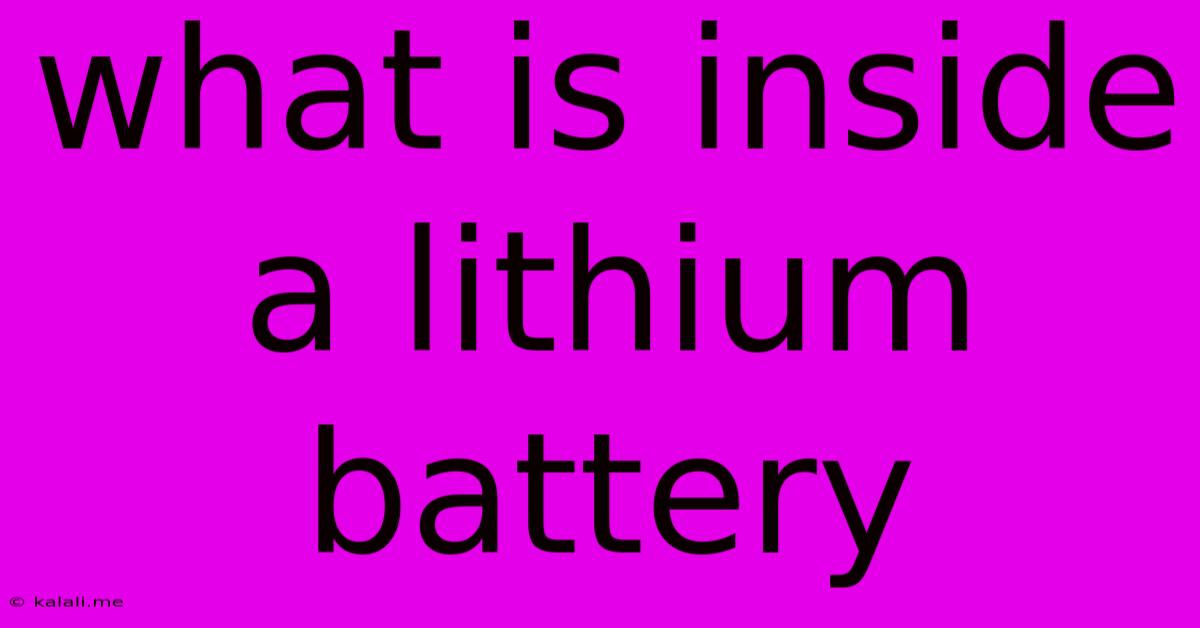What Is Inside A Lithium Battery
Kalali
May 19, 2025 · 3 min read

Table of Contents
What's Inside a Lithium Battery? Unpacking the Powerhouse
Lithium-ion batteries power our smartphones, laptops, electric vehicles, and countless other devices. But what exactly is inside these ubiquitous powerhouses? Understanding their internal components is key to appreciating their functionality, safety, and limitations. This article delves into the intricate workings of a lithium-ion battery, explaining its core components and their roles.
Anode: The Electron Donor
At the heart of a lithium-ion battery lies the anode, the negative electrode. Traditionally, this was made of graphite, a form of carbon that readily accepts and releases lithium ions. However, newer battery technologies are exploring alternative anode materials like silicon, which offers significantly higher energy density but presents challenges in terms of stability and lifespan. The anode's role is crucial; it stores lithium ions when the battery is charging and releases them during discharge, supplying electrons to the external circuit. The choice of anode material significantly impacts the battery's overall performance and longevity.
Cathode: The Electron Acceptor
The cathode, the positive electrode, is where the lithium ions travel during discharge. Common cathode materials include lithium cobalt oxide (LiCoO2), lithium manganese oxide (LiMn2O4), lithium nickel manganese cobalt oxide (NMC), and lithium iron phosphate (LiFePO4). Each material possesses unique characteristics affecting the battery's energy density, charging rate, lifespan, and cost. The cathode's chemical composition is a critical determinant of the battery's overall performance characteristics. For example, LiFePO4 cathodes are known for their safety and longevity, while NMC cathodes offer higher energy density.
Electrolyte: The Ion Conductor
The electrolyte is a liquid, gel, or solid material that allows lithium ions to move between the anode and cathode. It's crucial for completing the electrical circuit. The electrolyte must be chemically stable and prevent short circuits, ensuring safe battery operation. The electrolyte's properties significantly influence the battery's overall safety and performance. Research is ongoing to develop solid-state electrolytes, which promise improved safety and energy density.
Separator: Preventing Short Circuits
A thin, porous separator sits between the anode and cathode. Its primary function is to prevent direct contact between these two electrodes, which would cause a short circuit and potentially damage or ignite the battery. The separator allows the passage of lithium ions while blocking electrons, ensuring controlled ion flow. The separator's integrity is paramount to battery safety. Various materials, including polymers and ceramics, are used to create these separators.
Current Collectors:
Both the anode and cathode need current collectors – typically metallic foils (aluminum for the cathode and copper for the anode) – to facilitate electron flow. These foils provide a conductive pathway for the electrons to enter and leave the battery, enabling the external circuit to function.
Packaging & Terminals:
The entire battery assembly is enclosed within a robust casing, often made of metal or plastic, to protect the internal components from external elements and to maintain structural integrity. Terminals, typically made of metal, connect to the external circuit, allowing for the flow of electrons. The packaging must be strong and durable enough to withstand the physical stresses of normal usage and potential accidental damage.
Understanding the interplay of these components allows us to better understand how lithium-ion batteries work, their limitations, and the ongoing research aimed at improving their performance, safety, and sustainability. Future advancements will likely involve improvements in materials science, leading to even higher energy density, faster charging times, longer lifespans, and enhanced safety features.
Latest Posts
Latest Posts
-
Sink Not Draining But Pipes Clear
May 20, 2025
-
What Is The Country Of Issue On A Passport
May 20, 2025
-
Can I Mix 5w30 And 5w40
May 20, 2025
-
How Long Will Fresh Turkey Keep In Refrigerator
May 20, 2025
-
What Is The Ph Of H2so4
May 20, 2025
Related Post
Thank you for visiting our website which covers about What Is Inside A Lithium Battery . We hope the information provided has been useful to you. Feel free to contact us if you have any questions or need further assistance. See you next time and don't miss to bookmark.